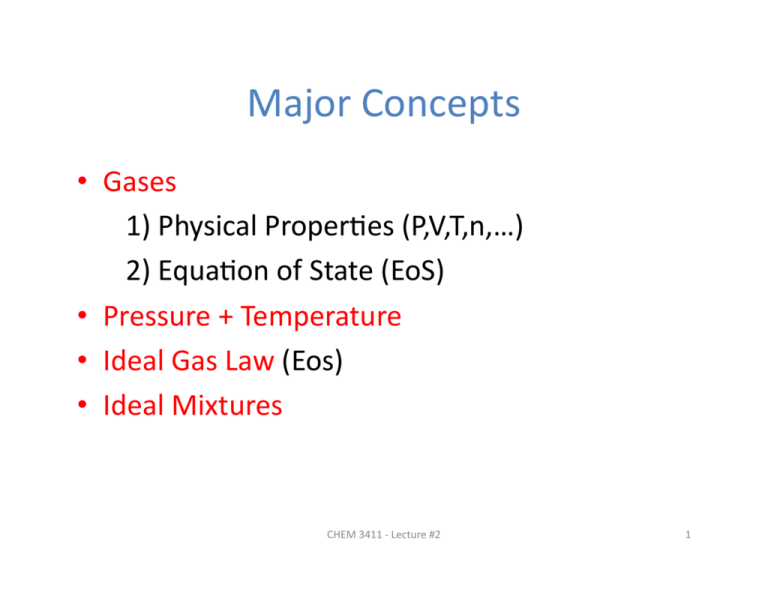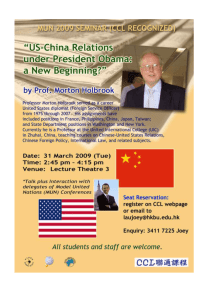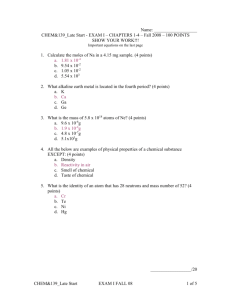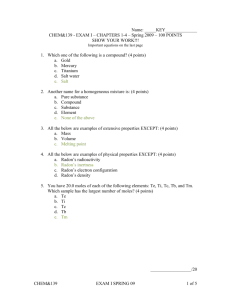Major Concepts
advertisement

Major Concepts • Gases 1) Physical Proper6es (P,V,T,n,…) 2) Equa6on of State (EoS) • Pressure + Temperature • Ideal Gas Law (Eos) • Ideal Mixtures CHEM 3411 -­‐ Lecture #2 1 Gases + The Equa6on of State • Def: Gas: A form of maQer that fills any container. • Def: Physical State: The physical condi6on of a system defined by its physical proper6es. Q: What is the difference between a physical state and a state? Q: Are all the physical proper6es independent of each other? A: Equa6on of state (Rela6on between dependent proper6es – variables. Q: What are the physical proper6es specifying a “state”? CHEM 3411 -­‐ Lecture #2 2 Gases + The Equa6on of State • P Pressure P = f(T,V,n) • V Volume • N Number • T Temperature • S Entropy S = f1(T,V,n) • µ Chemical Poten6al µ = f2(T,V,n) In a Gas only three independent proper6es are needed. CHEM 3411 -­‐ Lecture #2 3 Pressure • Def: Force/unit area Equal states (equilibrium) Two chambers with gas that have a common movable wall will have the same pressure. When the wall will stop moving the two gas in the two chambers will be in a Mechanical Equilibrium CHEM 3411 -­‐ Lecture #2 4 Pressure • Units: 1 Pa (Pascal) = 1N/m2 = 1 Kg/(ms2) = 10g/(cms2) 1 Bar = 105 Pa 1 Atm = 101,325 Pa = 760 torr 1 psi = 6.894… Kpa Def: STP: PSTP ~ 1 atm SATP (Standard ambient temperature and pressure): Pᴓ ≡ 105 Pa CHEM 3411 -­‐ Lecture #2 5 Temperature • Def: A property that indicates the direc6on of energy flow through a conduc6ve, rigid wall. Boundaries (walls) : Adiaba6c = no energy flow – thermal insulator. Diathermic = energy flow (therma connductor) Def: Thermal Equilibrium: No change of state between two objects with common diathermic wall. Zeroth law of Thermodynamics: Transi6vity of thermal equilibrium. Units: Fahrenheit : Celsius scales: (θ/0F) = 9/5(θ/0c)+ 32 Kelvin Scale: (T/K) = (θ/0c) + 273.15 Def: θSTP = 00C and Tᴓ = 298.15K CHEM 3411 -­‐ Lecture #2 6 Gas Law: Ideal Gas E.o.S • • • • Boyle’s Law (P α (1/V)T,n Charles’ or Gay Lussac’s law (V α T) P,n Charles’ law (P α T) V,n Avogadro’s Principle (V α n) P,T Perfect or ideal gas law: PV = n R T Observa6on: At STP (θSTP = 00C, PSTP ≈1 atm) (V/n) = 22.41 L/mole CHEM 3411 -­‐ Lecture #2 7 Constants Note: R(gas constant) = Na(Avogadro number)* K(Boltzman constant) R =8.3147 J/K*mole, Na = 6.02214*1023(par6cle/mole), K = 1.38065*10-­‐23(j/K) CHEM 3411 -­‐ Lecture #2 8 Ideal Mixture of Gases • Dalton’s Law: The pressure exerted by a mixture of gases is the sum of the par6al pressures. ADDITIVITY! Suppose we have a mixture of Na helium atoms and Nb argon atoms (at constant V and T) Q: What is the total pressure? A: Par6al pressure of helium: Pa = Na(RT/V) par6al pressure of argon: Pb = Nb(RT/V) Addi6vity: PT = Pa + Pb = (Na+Nb)(RT/V) CHEM 3411 -­‐ Lecture #2 9 Ideal Mixture of Gases • Def: Mole frac6on: Xa = Na/NT = (Na/NT )*(RT/V)/(RT/V) = Pa/PT CHEM 3411 -­‐ Lecture #2 10






